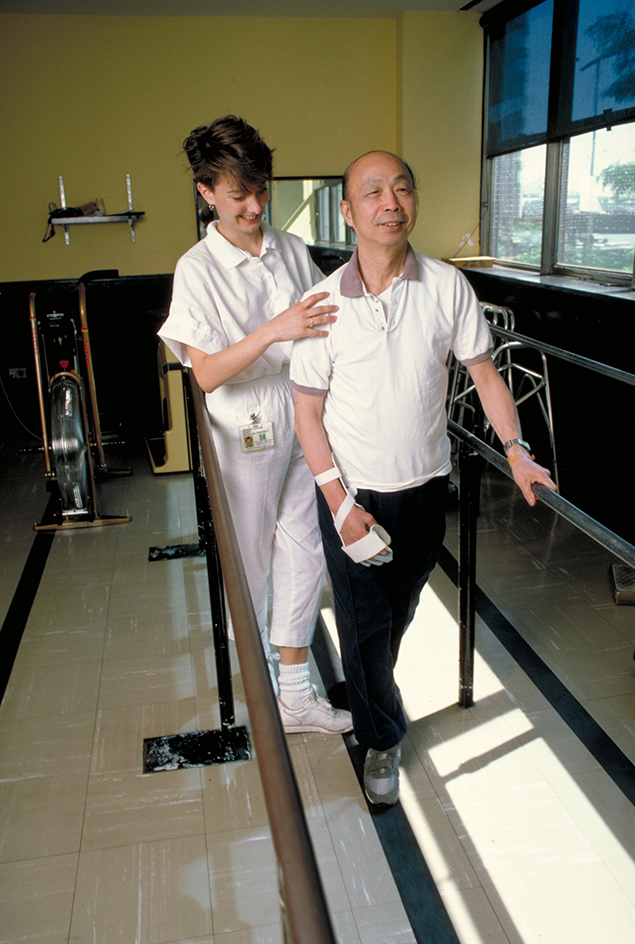Stroke is the sudden loss of brain function. It is a medical emergency that may result in paralysis, severe brain damage, or death. Most strokes occur when a blood clot blocks the flow of blood to the brain. The blockage interrupts the brain’s supply of oxygen and nutrients. Permanent brain damage occurs if the blockage lasts more than a few minutes. Strokes also may occur when a blood vessel ruptures and bleeds into the brain or the fluid around the brain. The bleeding produces pressure and swelling that damages brain tissue.

Stroke is a major health problem throughout the world. In the United States, hundreds of thousands of strokes occur each year, and more than 150,000 of them are fatal. Most people who survive their first stroke soon regain some lost brain function. They may regain more over several years. People who suffer two or more strokes are more often permanently disabled. Most stroke victims are age 65 or older.
Symptoms
of stroke depend on the areas of the brain affected. The most common symptoms include sudden weakness or loss of sensation on one side of the body, partial loss of vision, dizziness, or slurred speech. They also include difficulty producing or understanding words, loss of balance, or loss of coordination of the arms or legs. Symptoms may be serious at onset or become worse over several hours or days. In some people, the progression of symptoms leads to coma and death, usually due to brain swelling. In some minor strokes, symptoms disappear quickly with no lasting brain damage. Such events are called transient ischemic attacks (TIA’s). TIA’s often precede a more serious stroke.
Causes.
Most strokes are caused by blockage of blood flow to the brain. The blockage may result from either cerebral thrombosis or cerebral embolism. Cerebral thrombosis occurs when a blood clot forms in a major blood vessel to the brain. It occurs more often in people who have atherosclerosis (hardening of the arteries) in the brain or the neck (see Arteriosclerosis). Factors that increase the risk of thrombosis from atherosclerosis include hypertension (high blood pressure), diabetes, high blood-cholesterol levels, and cigarette smoking. Cerebral embolism involves a clot that forms in another part of the body, usually the heart or a major artery. The clot moves in the bloodstream until it lodges in a vessel that supplies the brain. Cerebral embolism is common in people with heart disease, atrial fibrillation (irregular heart rhythms), and atherosclerosis.
Another major cause of strokes is cerebral hemorrhage. Cerebral hemorrhage is bleeding into the brain from a ruptured blood vessel. Cerebral hemorrhage can be caused by hypertension, malformations of the brain’s arteries and veins, or, especially in elderly people, disease of brain arteries (see Cerebral hemorrhage).
Strokes also may result from bleeding into the cerebrospinal fluid. This bleeding is called subarachnoid hemorrhage. It often results from a cerebral aneurysm. A cerebral aneurysm is a defect in the wall of a blood vessel in the brain.
Prevention.
To avoid strokes, people should have their blood pressure checked frequently. Those with elevated blood pressure should take measures to bring down their blood pressure. They can do this through diet or medication as directed by a doctor. For people with atherosclerosis or atrial fibrillation, doctors prescribe aspirin or other drugs called anticoagulants. These drugs thin the blood. They can help prevent strokes in people with certain types of heart disease or atrial fibrillation. Doctors may also prescribe statins. These drugs lower blood cholesterol. They help decrease the risk of another stroke in people with high cholesterol and a history of stroke or TIA.
People with severe atherosclerosis of the large arteries, especially the carotid arteries in the neck, may benefit from a surgery called carotid endarterectomy. This procedure removes the hardened inner lining of the carotid arteries. The surgery allows blood to flow freely. It reduces the chance that additional clots will form.
Treatment.
For many years, there was no direct treatment for stroke. The aim of medical care was to prevent complications and reduce the risk of a second stroke. Complications from stroke include pneumonia, other infections, and bedsores. In 1995, a major study showed that a clot-dissolving drug could improve recovery from strokes due to blood clots. This drug is called tissue plasminogen activator (tPA). The treatment usually must be given within three hours of the stroke’s onset. However, a few people may benefit from this treatment up to four or more hours after the onset of a stroke. Within 24 hours, doctors may also thread a device into a blocked artery to remove a clot and restore blood flow. Anyone with symptoms of stroke should seek immediate care.
Rehabilitation
helps regain lost function for many victims who can work with therapists. Physical therapists help paralyzed stroke patients move to prevent muscle stiffening. Physical therapists also use exercises and treatment with heat, water, and massage to help patients perform daily tasks. Speech therapists help stroke victims with speech and language disabilities. Occupational therapists help patients coordinate hand and eye movements. Such therapy helps patients to perform basic tasks, such as writing and preparing food. See Occupational therapy; Physical therapy; Speech therapy.
Scientists have done much research on how the brain recovers function following stroke. A rehabilitation technique called constraint-induced movement therapy helps stroke victims regain use of paralyzed limbs. In this therapy, patients perform up to six hours of exercise with the weak limb. At the same time, the opposite, unaffected limb is restrained. Scientists think the intensive therapy causes the person’s brain to grow new nerve connections, restoring lost function. Such research offers hope that someday stroke victims may regain full use of the brain.
